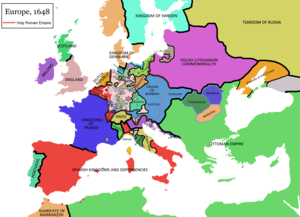Peace of Westphalia

The Peace of Westphalia refers to the pair of peace treaties, the Treaty of Osnabrück and the Treaty of Münster, signed on May 15 and October 24 of 1648, which ended both the Thirty Years' War and the Eighty Years' War. The treaties involved Holy Roman Emperor Ferdinand III, the other German princes, Spain, France, Sweden and representatives of the Dutch Republic. The Treaty of the Pyrenees, signed in 1659, ending the war between France and Spain, is also often considered part of the overall agreement.
Locations
[change | change source]The peace negotiations were held in the cities of Münster and Osnabrück, which lie about 50 km apart from each other, in the present German states of North Rhine-Westphalia and Lower Saxony. Sweden had favoured Osnabrück because of its Protestant background, France chose Münster because of its Catholic background. In any case, two locations were required because the Protestant and Catholic leaders refused to meet each other. The Catholics used Münster, and the Protestants used Osnabrück.
Results
[change | change source]Spain accepted the independence of the Dutch Republic.

The power that Ferdinand III had taken for himself against the Holy Roman Empire's constitution was stripped. That meant that the rulers of the German states could again determine the religion of their lands.
- All parties would now recognize the Peace of Augsburg of 1555 by which each prince would have the right to determine the religion of his own state, whether Catholicism, Lutheranism or now Calvinism.
- Christians living in principalities in which their denomination was not the established church were guaranteed the right to practice their faith in public during allotted hours and in private at their will.

There were also territorial adjustments.
Related pages
[change | change source]Other websites
[change | change source]- Treaty Text Archived 2006-07-18 at the Wayback Machine
- Treaty Text (Yale University)
- Texts of the Westphalian Treaties
- High Resolution Map of Germany after the Treaty of Westphalia
- Peace Treaty of Osnabrück (Full Text) Archived 2019-09-13 at the Wayback Machine
- Peace Treaty of Münster (Full Text) Archived 2019-09-13 at the Wayback Machine